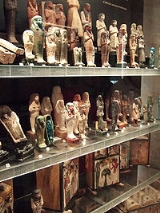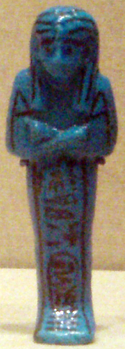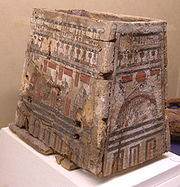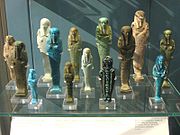
Ushabti
Encyclopedia
The ushabti was a funerary figurine used in Ancient Egypt
. Ushabtis were placed in tombs among the grave goods
and were intended to act as substitutes for the deceased, should he/she be called upon to do manual labor in the afterlife. They were used from the Middle Kingdom
(around 1900 BC) until the end of the Ptolemaic Period nearly 2000 years later.
Most ushabtis were of minor size, and many produced in multiples – they sometimes covered the floor around a sarcophagus. Exceptional ushabtis are of larger size, or produced as a one-of-a-kind master work.
Due to the shabti's commonness through all Egyptian timeperiods, and world museums' desire to represent ancient Egypt
ian art objects, the shabti is one of the most commonly represented objects in Egyptology displays.
 The term shabti applies to these figures prior to the Twenty-first dynasty of Egypt
The term shabti applies to these figures prior to the Twenty-first dynasty of Egypt
but after the end of the First Intermediate Period, and really only to figurines inscribed with Chapter Six of the Book of the Dead
. Otherwise, they might better be defined by the generic term, funerary figurines.
The shabtis were servant figures that carried out the tasks required of the deceased in the underworld. The scribe Nebseni, the draughtsman in the Temple of Ptah, says, "Oh you shabti figure of the scribe Nebseni, son of the scribe Thena
, and of the lady of the house Muthrestha, if I be called, or if I be judged to do any work whatever of the labours which are to be done in the underworld - behold, for your opposition will there be set aside - by a man in his turn, let the judgment fall upon you instead of upon me always, in the matter of sowing the fields, of filling the water-courses with water, and of bringing the sands of the east to the west."
The shabti figure answers, "I am here and will come wherever you bid me."
The shawabti were a distinct class of funerary figurines within the area of Thebes
during the New Kingdom
.
The term ushabti became prevalent after the 21st Dynasty and remained in use until Ptolemaic times..
It is thought by some that the term ushabti meant "follower" or "answerer" in Ancient Egyptian, because the figurine "answered" for the deceased person and performed all the routine chores of daily life for its master, though it would be difficult to reconcile this derivation with the form of shawabti.
“Illumine the Osiris NN, whose word is truth. Hail, Shabti Figure! If the Osiris [name of deceased] be decreed to do any of the work which is to be done in Khert-Neter, let everything which standeth in the way be removed from him- whether it be to plough the fields, or to fill the channels with water, or to carry sand from the East to the West. The Shabti Figure replieth: "I will do it, verily I am here when thou callest”. "
(Example, for NN, Akhenaten
, "Osiris Akhenaten").
In rare cases different chapters of the Book of the Dead are written. Furthermore, shabtis often mention the name and the titles of the owner, without the spells of the Book of the Dead.
Before being inscribed on funerary figurines, the spell was written on some mid-Twelfth Dynasty
coffins from Bersheh (about 1850 BC) and is known today as spell 472 of the Coffin Texts
.
 Mentioned first in spell 472 of the Coffin Texts
Mentioned first in spell 472 of the Coffin Texts
they were included in the grave goods
of the dead as small figurines since the reign of Mentuhotep II of the 11th Dynasty
. Some think that originally they may have symbolically replaced genuine sacrificial burials, a somewhat improbable theory as centuries had passed between the last known sacrificial burials and the appearance of the ushabtis. They were generally distinguished from other statuettes by being inscribed with the name of the deceased, his titles, and often with spell 472 of the Coffin Texts or the speech of the Shabti figure found in Chapter Six of the Book of the Dead
. In the 18th Dynasty during the reign of Amenhotep IV, the figurines were inscribed with an offering addressed to the sun disk, Aten, rather than the traditional speech of the Shabti figure.The ushabti was believed to magically animate after the dead had been judged, and work for the dead person as a substitute labourer in the fields of Osiris
. From the New Kingdom
onwards, it was often referred to as servant.
From the 21st Dynasty on ushabtis became common and numerous in graves. In some tombs the floor was covered with a great many ushabti figurines; in others the ushabtis were neatly packed into ushabti boxes. At times several hundred ushabti were placed in a deceased Ancient Egyptian's tomb, but pharaohs had considerably more of these servants than commoners, and king Taharqa
had more than a thousand. Some tombs contained overseer or 'reis' ushabtis holding a whip, which were responsible for groups of ten ushabti each - (ten being a common administrative division, for example in the armies). These overseers became rare during the Late Period.
had a large number of shabtis. However, the shabtis were of varying sizes, and most were ornate, with hieroglyph statements. The Tutankhamun shabtis were in sub-groups; some honored Osiriform gods, gold-foiled; some were more simple of wood, or faience
.
 Ushabtis were mostly mummiform, but in the 18th Dynasty during the reign of Tuthmosis IV they began to be fashioned as servants with baskets, sacks, and other agricultural tools. They were made of clay, wood or stone, early ones were sometimes also made from wax
Ushabtis were mostly mummiform, but in the 18th Dynasty during the reign of Tuthmosis IV they began to be fashioned as servants with baskets, sacks, and other agricultural tools. They were made of clay, wood or stone, early ones were sometimes also made from wax
. Later figurines were often made of less perishable materials: stone, terracotta, metal, glass and, most frequently, glazed earthenware (faience
). While ushabtis manufactured for the rich were often miniature works of art, the great mass of cheaply made ushabtis became standardised—made from single molds with little detail.
Produced in huge numbers, ushabtis, along with scarabs
, are the most numerous of all ancient Egyptian antiquities to survive.
Ancient Egypt
Ancient Egypt was an ancient civilization of Northeastern Africa, concentrated along the lower reaches of the Nile River in what is now the modern country of Egypt. Egyptian civilization coalesced around 3150 BC with the political unification of Upper and Lower Egypt under the first pharaoh...
. Ushabtis were placed in tombs among the grave goods
Grave goods
Grave goods, in archaeology and anthropology, are the items buried along with the body.They are usually personal possessions, supplies to smooth the deceased's journey into the afterlife or offerings to the gods. Grave goods are a type of votive deposit...
and were intended to act as substitutes for the deceased, should he/she be called upon to do manual labor in the afterlife. They were used from the Middle Kingdom
Middle Kingdom of Egypt
The Middle Kingdom of Egypt is the period in the history of ancient Egypt stretching from the establishment of the Eleventh Dynasty to the end of the Fourteenth Dynasty, between 2055 BC and 1650 BC, although some writers include the Thirteenth and Fourteenth dynasties in the Second Intermediate...
(around 1900 BC) until the end of the Ptolemaic Period nearly 2000 years later.
Most ushabtis were of minor size, and many produced in multiples – they sometimes covered the floor around a sarcophagus. Exceptional ushabtis are of larger size, or produced as a one-of-a-kind master work.
Due to the shabti's commonness through all Egyptian timeperiods, and world museums' desire to represent ancient Egypt
Ancient Egypt
Ancient Egypt was an ancient civilization of Northeastern Africa, concentrated along the lower reaches of the Nile River in what is now the modern country of Egypt. Egyptian civilization coalesced around 3150 BC with the political unification of Upper and Lower Egypt under the first pharaoh...
ian art objects, the shabti is one of the most commonly represented objects in Egyptology displays.
Etymology and usage of the terms

Twenty-first dynasty of Egypt
The Twenty-First, Twenty-Second, Twenty-Third, Twenty-Fourth, and Twenty-Fifth Dynasties of ancient Egypt are often combined under the group title, Third Intermediate Period.-Rulers:...
but after the end of the First Intermediate Period, and really only to figurines inscribed with Chapter Six of the Book of the Dead
Book of the Dead
The Book of the Dead is the modern name of an ancient Egyptian funerary text, used from the beginning of the New Kingdom to around 50 BC. The original Egyptian name for the text, transliterated rw nw prt m hrw is translated as "Book of Coming Forth by Day". Another translation would be "Book of...
. Otherwise, they might better be defined by the generic term, funerary figurines.
The shabtis were servant figures that carried out the tasks required of the deceased in the underworld. The scribe Nebseni, the draughtsman in the Temple of Ptah, says, "Oh you shabti figure of the scribe Nebseni, son of the scribe Thena
Thena
Thena is a fictional character appearing in the Marvel Comics universe. She is a member of the Eternals.- Fictional character biography :Thena was born in the city of Olympia in ancient Greece, and is thus one of the Eternals of Olympia...
, and of the lady of the house Muthrestha, if I be called, or if I be judged to do any work whatever of the labours which are to be done in the underworld - behold, for your opposition will there be set aside - by a man in his turn, let the judgment fall upon you instead of upon me always, in the matter of sowing the fields, of filling the water-courses with water, and of bringing the sands of the east to the west."
The shabti figure answers, "I am here and will come wherever you bid me."
The shawabti were a distinct class of funerary figurines within the area of Thebes
Thebes, Egypt
Thebes is the Greek name for a city in Ancient Egypt located about 800 km south of the Mediterranean, on the east bank of the river Nile within the modern city of Luxor. The Theban Necropolis is situated nearby on the west bank of the Nile.-History:...
during the New Kingdom
New Kingdom
The New Kingdom of Egypt, also referred to as the Egyptian Empire is the period in ancient Egyptian history between the 16th century BC and the 11th century BC, covering the Eighteenth, Nineteenth, and Twentieth Dynasties of Egypt....
.
The term ushabti became prevalent after the 21st Dynasty and remained in use until Ptolemaic times..
It is thought by some that the term ushabti meant "follower" or "answerer" in Ancient Egyptian, because the figurine "answered" for the deceased person and performed all the routine chores of daily life for its master, though it would be difficult to reconcile this derivation with the form of shawabti.
Inscriptions
Shabti inscriptions often contain the 6th chapter of the Book of the Dead, translated as:“Illumine the Osiris NN, whose word is truth. Hail, Shabti Figure! If the Osiris [name of deceased] be decreed to do any of the work which is to be done in Khert-Neter, let everything which standeth in the way be removed from him- whether it be to plough the fields, or to fill the channels with water, or to carry sand from the East to the West. The Shabti Figure replieth: "I will do it, verily I am here when thou callest”. "
(Example, for NN, Akhenaten
Akhenaten
Akhenaten also spelled Echnaton,Ikhnaton,and Khuenaten;meaning "living spirit of Aten") known before the fifth year of his reign as Amenhotep IV , was a Pharaoh of the Eighteenth dynasty of Egypt who ruled for 17 years and died perhaps in 1336 BC or 1334 BC...
, "Osiris Akhenaten").
In rare cases different chapters of the Book of the Dead are written. Furthermore, shabtis often mention the name and the titles of the owner, without the spells of the Book of the Dead.
Before being inscribed on funerary figurines, the spell was written on some mid-Twelfth Dynasty
Twelfth dynasty of Egypt
The twelfth dynasty of ancient Egypt is often combined with Dynasties XI, XIII and XIV under the group title Middle Kingdom.-Rulers:Known rulers of the twelfth dynasty are as follows :...
coffins from Bersheh (about 1850 BC) and is known today as spell 472 of the Coffin Texts
Coffin Texts
The Coffin Texts are a collection of ancient Egyptian funerary spells written on coffins beginning in the First Intermediate Period. The texts are derived in part from the earlier pyramid texts, reserved for royal use only, but they contain substantial new material related to everyday desires that...
.
History of usage

Coffin Texts
The Coffin Texts are a collection of ancient Egyptian funerary spells written on coffins beginning in the First Intermediate Period. The texts are derived in part from the earlier pyramid texts, reserved for royal use only, but they contain substantial new material related to everyday desires that...
they were included in the grave goods
Grave goods
Grave goods, in archaeology and anthropology, are the items buried along with the body.They are usually personal possessions, supplies to smooth the deceased's journey into the afterlife or offerings to the gods. Grave goods are a type of votive deposit...
of the dead as small figurines since the reign of Mentuhotep II of the 11th Dynasty
Middle Kingdom of Egypt
The Middle Kingdom of Egypt is the period in the history of ancient Egypt stretching from the establishment of the Eleventh Dynasty to the end of the Fourteenth Dynasty, between 2055 BC and 1650 BC, although some writers include the Thirteenth and Fourteenth dynasties in the Second Intermediate...
. Some think that originally they may have symbolically replaced genuine sacrificial burials, a somewhat improbable theory as centuries had passed between the last known sacrificial burials and the appearance of the ushabtis. They were generally distinguished from other statuettes by being inscribed with the name of the deceased, his titles, and often with spell 472 of the Coffin Texts or the speech of the Shabti figure found in Chapter Six of the Book of the Dead
Book of the Dead
The Book of the Dead is the modern name of an ancient Egyptian funerary text, used from the beginning of the New Kingdom to around 50 BC. The original Egyptian name for the text, transliterated rw nw prt m hrw is translated as "Book of Coming Forth by Day". Another translation would be "Book of...
. In the 18th Dynasty during the reign of Amenhotep IV, the figurines were inscribed with an offering addressed to the sun disk, Aten, rather than the traditional speech of the Shabti figure.The ushabti was believed to magically animate after the dead had been judged, and work for the dead person as a substitute labourer in the fields of Osiris
Osiris
Osiris is an Egyptian god, usually identified as the god of the afterlife, the underworld and the dead. He is classically depicted as a green-skinned man with a pharaoh's beard, partially mummy-wrapped at the legs, wearing a distinctive crown with two large ostrich feathers at either side, and...
. From the New Kingdom
New Kingdom
The New Kingdom of Egypt, also referred to as the Egyptian Empire is the period in ancient Egyptian history between the 16th century BC and the 11th century BC, covering the Eighteenth, Nineteenth, and Twentieth Dynasties of Egypt....
onwards, it was often referred to as servant.
From the 21st Dynasty on ushabtis became common and numerous in graves. In some tombs the floor was covered with a great many ushabti figurines; in others the ushabtis were neatly packed into ushabti boxes. At times several hundred ushabti were placed in a deceased Ancient Egyptian's tomb, but pharaohs had considerably more of these servants than commoners, and king Taharqa
Taharqa
Taharqa was a pharaoh of the Ancient Egyptian 25th dynasty and king of the Kingdom of Kush, which was located in Northern Sudan.Taharqa was the son of Piye, the Nubian king of Napata who had first conquered Egypt. Taharqa was also the cousin and successor of Shebitku. The successful campaigns of...
had more than a thousand. Some tombs contained overseer or 'reis' ushabtis holding a whip, which were responsible for groups of ten ushabti each - (ten being a common administrative division, for example in the armies). These overseers became rare during the Late Period.
Modern museum shabti displays
The tomb of TutankhamunTutankhamun
Tutankhamun , Egyptian , ; approx. 1341 BC – 1323 BC) was an Egyptian pharaoh of the 18th dynasty , during the period of Egyptian history known as the New Kingdom...
had a large number of shabtis. However, the shabtis were of varying sizes, and most were ornate, with hieroglyph statements. The Tutankhamun shabtis were in sub-groups; some honored Osiriform gods, gold-foiled; some were more simple of wood, or faience
Faience
Faience or faïence is the conventional name in English for fine tin-glazed pottery on a delicate pale buff earthenware body, originally associated with Faenza in northern Italy. The invention of a white pottery glaze suitable for painted decoration, by the addition of an oxide of tin to the slip...
.
Shape and material

Wax
thumb|right|[[Cetyl palmitate]], a typical wax ester.Wax refers to a class of chemical compounds that are plastic near ambient temperatures. Characteristically, they melt above 45 °C to give a low viscosity liquid. Waxes are insoluble in water but soluble in organic, nonpolar solvents...
. Later figurines were often made of less perishable materials: stone, terracotta, metal, glass and, most frequently, glazed earthenware (faience
Faience
Faience or faïence is the conventional name in English for fine tin-glazed pottery on a delicate pale buff earthenware body, originally associated with Faenza in northern Italy. The invention of a white pottery glaze suitable for painted decoration, by the addition of an oxide of tin to the slip...
). While ushabtis manufactured for the rich were often miniature works of art, the great mass of cheaply made ushabtis became standardised—made from single molds with little detail.
Produced in huge numbers, ushabtis, along with scarabs
Scarab artifact
Scarabs were popular amulets in ancient Egypt. According to ancient Egyptian myths, the sun rolls across the sky each day and transforms bodies and souls. Modeled upon the Scarabaeidae family dung beetle, which rolls dung into a ball for the purposes of eating and laying eggs that are later...
, are the most numerous of all ancient Egyptian antiquities to survive.
Further reading
- Bob Brier, The Encyclopedia of Mummies, Checkmark Books, 1998
- Harry M. Stewart: Egyptian Shabtis, Princes Risborough 1995
- James, 2000, Tutankhamun, T.G.H. James, Photographs, Araldo de Luca, c 2000, Friedman/Fairfax Publishers. Picture-book, (over-sized), 319 pp. List of Objects, p 316-319, (about 350+). {hardcover, ISBN 1-58663-032-6}
- Paul Whelan: Mere Scraps of Rough Wood?: 17th - 18th Dynasty Stick Shabtis in the Petrie Museum and Other Collections, London 2007 ISBN 978-1906137007

